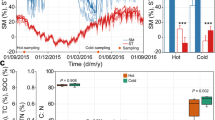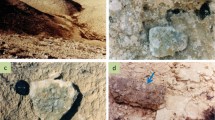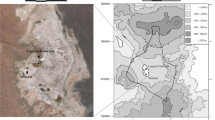Abstract
Two cryptoendolithic microbial communities, lichens in the Ross Desert of Antarctica and cyanobacteria in the Negev Desert, inhabit porous sandstone rocks of similar physical structure. Both rock types adsorb water vapor by physical mechanisms unrelated to biological processes. Yet the two microbial communities respond differently to water stress: cryp-toendolithic lichens begin to photosynthesize at a matric water potential of −46.4 megaPascals (MPa) [70% relative humidity (RH) at 8°C], resembling thallose desert lichens. Cryptoendolithic cyanobacteria, like other prokaryotes, photosynthesize only at very high matric water potentials [> −6.9 MPa, 90% RH at 20°C].
Similar content being viewed by others
References
Belly R, Brock T (1967) Ecology of iron-oxidizing bacteria in pyritic materials associated with coal. J Bacteriol 117:726–732
Friedmann EI (1971) Light and scanning electron microscopy of the endolithic desert algal habitat. Phycologia 10:411–428
Friedmann EI (1977) Microorganisms in Antarctic desert rocks from dry valleys and Dufek Massif. Antarct J US 12:26–30
Friedmann EI (1978) Melting snow in the dry valleys is a source of water for endolithic microorganisms. Antarct J US 13:162–163
Friedmann EI (1980) Endolithic microbial life in hot and cold deserts. Origins Life 10:223–235
Friedmann EI (1982) Endolithic microorganisms in the Antarctic cold desert. Science 215:1045–1053
Friedmann EI, Hua M, Ocampo-Friedmann R (1988) Cryptoendolithic lichen and cyanobacterial communities of the Ross Desert, Antarctica. Polarforschung 58:251–260
Friedmann EI, Lipkin Y, Ocampo-Paus R (1967) Desert algae of the Negev (Israel). Phycologia 6:185–196
Friedmann EI, McKay CP, Nienow JA (1987) The cryptoendolithic microbial environment in the Ross Desert of Antarctica: continuous nanoclimate data, 1984 to 1986. Polar Biol 7:237–287
Friedmann EI, Ocampo-Friedmann R (1984) Endolithic microorganisms in extreme dry environments: analysis of a lithobiontic microbial habitat. In: Reddy CA (ed) Current perspectives in microbial ecology. American Society for Microbiology, Washington, DC, pp 177–185
Friedmann EI, Ocampo-Friedmann R (1985) Blue-green algae in arid cryptoendolithic habitats. Arch Hydrobiol Suppl 71:349–350
Golubic S, Friedmann I, Schneider J (1981) The lithobiontic ecological niche, with special reference to microorganisms. J Sediment Petrol 51:475–478
Greenfield LG (1988) Forms of nitrogen in Beacon sandstone rocks containing endolithic microbial communities in Southern Victoria Land, Antarctica. Polarforschung 58:211–218
Griffin DM, Luard EJ (1979) Water stress and microbial ecology. In: Shilo M (ed) Strategies of microbial life in extreme environments. Verlag Chemie, Weinheim, New York, pp 49–64
Kappen L, Friedmann EI (1983) Ecophysiology of lichens in the dry valleys of Southern Victoria Land, Antarctica. II. CO2 gas exchange in cryptoendolithic lichens. Polar Biol 1:227–232
Kappen L, Friedmann EI, Garty J (1981) Ecophysiology of lichens in the dry valleys of Southern Victoria Land, Antarctica. I. Microclimate of the cryptoendolithic lichen habitat. Flora 171:216–235
Katznelson I (1958) Rainfall in Palestine (in Hebrew). Meterological Papers 8:37–70
Lange OL, Kilian E, Ziegler H (1986) Water vapor uptake and photosynthesis of lichens: performance differences in species with green and blue-green algae as phycobionts. Oecologia 71:104–110
Lange OL, Schulze E, Koch W (1970) Experimentell-ökologische Untersuchungen an Flechten der Negev-Wüste. II. CO2-Gaswechsel und Wasserhaushalt vonRamalina maciformis (Del.) Bory am natürlichen Standort während der sommerlichen Trockenperiode. Flora 159:38–62
Lange OL, Matthes U (1981) Moisture-dependent CO2 exchange of lichens. Photosynthetica 15:555–574
Meeks JC, Castenholz RW (1971) Growth and photosynthesis in an extreme thermophile,Synechococcus lividus (Cyanophyta). Archiv Mikro 78:25–41
Nienow JA, McKay CP, Friedmann EI (1988) The cryptoendolithic microbial environment in the Ross Desert of Antarctica: light in the photosynthetically active region. Microb Ecology 16:271–289
O'Brien FEM (1948) The control of humidity by saturated salt solutions. J Sci Instrum 25:73–76
Palmer RJ Jr, Friedmann EI (1988) Incorporation of inorganic carbon by Antarctic cryptoendolithic fungi. Polarforschung 58:189–192
Palmer RJ Jr, Nienow JA, Friedmann EI (1987) Control of matric water potential by temperature differential. J Micro Methods 6:323–326
Potts M, Friedmann EI (1981) Effects of water stress on cryptoendolithic cyanobacteria from hot desert rocks. Arch Microbiol 130:267–271
Scherer S, Ernst A, Chen TW, Böger P (1984) Rewetting of drought-resistant blue-green algae: time course of water uptake and reappearance of respiration, photosynthesis and nitrogen fixation. Oecologia 62:418–423
Siebert J, Hirsch P (1988) Characterization of selected coccal bacteria isolated from Antarctic rock and soil samples from the McMurdo-Dry Valleys (South-Victoria Land). Polar Biol 9:37–44
Troller JA (1980) Influence of water activity on microorganisms in food. Food Technology May:76–80, 82
Vestal JR (1987) Carbon metabolism of the cryptoendolithic microbiota from the Antarctic desert. Appl Env Microbiol 54:960–965
Vestal JR, Friedmann EI (1983) In situ carbon metabolism by the cryptoendolithic microbial community in the Antarctic cold desert. Antarct J US 17(1982 review):190–191
de Winder B, Matthijs HCP, Mur LR (in press) The role of water retaining substrata on the photosynthetic response of three drought tolerant phototrophic microorganisms isolated from a terrestrial habitat. Arch Microbiol
Author information
Authors and Affiliations
Rights and permissions
About this article
Cite this article
Palmer, R.J., Friedmann, E.I. Water relations and photosynthesis in the cryptoendolithic microbial habitat of hot and cold deserts. Microb Ecol 19, 111–118 (1990). https://doi.org/10.1007/BF02015057
Issue Date:
DOI: https://doi.org/10.1007/BF02015057




